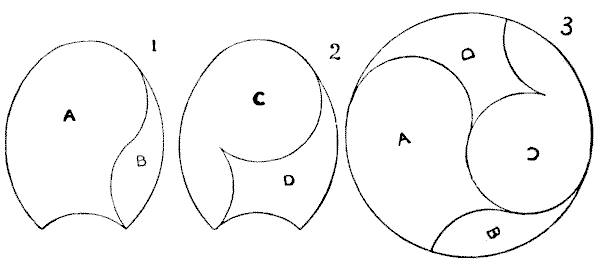(related to Problem: The Two Horseshoes)
The puzzle was to cut the two shoes (including the hoof contained within the outlines) into four pieces, two pieces each, that would fit together and form a perfect circle. It was also stipulated that all four pieces should be different in shape. As a matter of fact, it is a puzzle based on the principle contained in that curious Chinese symbol the Monad. (See The Great Monad)

The above diagrams give the correct solution to the problem. It will be noticed that $1$ and $2$ are cut into the required four pieces, all different in shape, that fit together and form the perfect circle shown in Diagram $3.$ It will further be observed that the two pieces $A$ and $B$ of one shoe and the two pieces $C$ and $D$ of the other form two exactly similar halves of the circle — the Yin and the Yan of the great Monad. It will be seen that the shape of the horseshoe is more easily determined from the circle than the dimensions of the circle from the horseshoe, though the latter presents no difficulty when you know that the curve of the long side of the shoe is part of the circumference of your circle. The difference between $B$ and $D$ is instructive, and the idea is useful in all such cases where it is a condition that the pieces must be different in shape. While forming $D$, we simply add on a symmetrical piece, a curvilinear square, to the piece $B.$ Therefore, in giving either $B$ or $D$ a quarter turn before placing in the new position, a precisely similar effect must be produced.
This eBook is for the use of anyone anywhere in the United States and most other parts of the world at no cost and with almost no restrictions whatsoever. You may copy it, give it away or re-use it under the terms of the Project Gutenberg License included with this edition or online at http://www.gutenberg.org. If you are not located in the United States, you'll have to check the laws of the country where you are located before using this ebook.